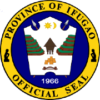

The name “HINGYON” was derived from the Ifugao term “HING-NGIYON”, meaning a diversion from a major route. The main route then, and even now, is the national road connecting the municipalities of Lagawe and Banaue and the diversion road is at Barangay Piwong, now a part of Hingyon, going towards the municipal mainland.
The Municipality of Hingyon was created by virtue of BATAS PAMBANSA Bilang 239, under P.D No. 1527 on September 12, 1982. This law states:
Cultural Background of Hingyon
If legend is to be believed, the people of Hingyon, like all other Ifugaos, are descendants of the first man and woman on earth. The man is named Wigan and the woman Bugan. They had children and the intermarriages of their offspring produced the people of Ifugao. In Hingyon, throughout the generations, there emerged three (3) distinct tribes. These are the Munkalyon Tribe (barangays Anao, Namulditan,Bangtinon, Bitu, and Piwong), the Mun-alyon Tribe (barangays Cababuyan North, Cababuyan South, O-ong, Ubuag, Umalbong, Mompolia and Poblacion), and the Ayangan tribe of Humalophop, Mompolia. The distinction is reflected in the pronunciation and intonation of the Ifugao dialect.
Based on accounts of American anthropologists like Samuel Kane, Harold Conklin, and Otley Beyer after Spain seceded the Philippines to the Americans in the early 1900’s, the early people of Hingyon (who were then included in Banaue and Lagawe) were pagans. They adored idols and practiced many rituals. Almost all occasions, whether merry making or mourning, call for the butchering of chickens, pigs or carabaos and drinking of the “baya” (native ricewine). In fact, one indication of the socio-economic status of an individual (or household) is the number of pigs or carabaos he has butchered, since this practice of butchering usually goes hand in hand with the collective wide area of his rice terraces. The more terraces he owned, the wealthier he is, the more respected he is in the village and the adjoining villages. Perhaps to inform strangers who come to the village, the house of the “kadangyan” (rich) is adorned by the skulls of carabaos butchered in the past.
As modernization came in, it brought changes in the villages including perceptions of people. Due to economic constraints (which has a direct impact to the butchering of ritual animals) and the entry of modern education and religion, many rituals have become things of the past. For instance, a new concept of “kadangyan” emerged in the villages. No longer were those who owned the widest terraces considered as rich, but rather, those who owned much money, or who earned much cash whether local or abroad. The terraces which were the symbols of wealth became symbols of hard labor, illiteracy, and poverty. The rituals and icons intended to please the “gods” for a bountiful harvest became idols of paganism and acts of worshipping them were considered “unchristian”. Respect shifted from the “kadangyan” or “muntonah” (who owned the widest terraces in the village) to people considered “educated”, and those who had much money.
Fortunately, some of the favorable cultural practices still persist up to the present.
“The boundary line of the new Municipality of Hingyon starts from the southernmost point of Ulling Mountain following the ridge of Nabatuan which is between barangay Cudog and Barangay Bangtinon. From there the line drops down to Awwa following the boundary between Barangay Cudog and Barangay Piwong. Turning eastward the line follows the ridge to Tuking along the boundary between Barangay Cudog and Barangay Anao. Then the line turns northward across the Anao River towards Mount Atugo following the boundary between Barangay Burnay and Barangay Anao. From Mount Atugo, the line turns eastward, drops down the ridge at Nundotallan which is the boundary between Barangay Burnay and Barangay Mompolia. Continuing down to the Umalbong River following the boundary between Barangay Burnay and Barangay Umalbong, the line goes across the river and climbs to the top of Mount Kahibag following the boundary between Barangay Boliwong and Barangay Umalbong. From this point, the line turns northward along the top ridges of Mount Kahibag, Mount Mungnginil and Mount Binanhayan which is the boundary line between Barangay Montabiong and Barangay Umalbong. From Mount Binanhayan, the line continues to the Iwigan Saddle where it turns northwestward following the boundary between Sitio Lapitan of Barangay Ducligan and Sitio Humalophop of Barangay Banao and between Sitio Ambawigon of Barangay Ducligan and Sitio Humalophop, all in Banaue municipality. The line reaches the Palo Mountain and from there, it drops downward on the slopes of Indonaal to the Banaue River at Guilot where if follows upstream the boundary between Barangay Kinakin and Barangay Ubuag. Going upstream the line reaches a point which is the boundary between Sitio Nabyon and Barangay Ubuag where it turns westward toward the Panawatan Mountain behind Ingunguy which is the boundary between Barangay Amaganad and Barangay Cababuyan. From Ingunguy, the line follows the Pongngot Ridge between sitio Lugo and Barangay Amganad until Puhpuh where it crosses the national road to follow the boundary between Sitio Amgode and Barangay O-ong. The line turns southward following the Anapawon Ridge which is the boundary between Lingay and O-ong, Lingay and Pitawan, and the Nungkigadan and Barangay Bangtinon until it reaches the southernmost point of Ulling Mountain. where the line started. All the area encompassed by this line becomes the territorial jurisdiction of the new Municipality of Hingyon.” (Source MPDC files)
Hingyon consisted then of eleven (11) barangays which were formerly parts of the municipalities of Lagawe and Banaue. On September 6, 1991, by virtue of Sangguniang Panlalawigan Resolution No.236, Series of 1991, Barangay Cababuyan was divided into Cababuyan North and South, thus, there became twelve (12) Barangays of the municipality
List of Barangays
| FORMERLY PART OF LAGAWE | FORMERLY PART OF BANAWE |
| 1.Anao | 1. Cababuyan-North |
| 2.Bangtinon | 2.Cababuyan-South |
| 3.Bitu | 3.O-0ng |
| 4.Mompolia | 4.Ubuag |
| 5.Namulditan | |
| 6.Piwong | |
| 7.Poblacion | |
| 8.Umalbong |
For more info Visit LGU Hingyon Facebook Page
